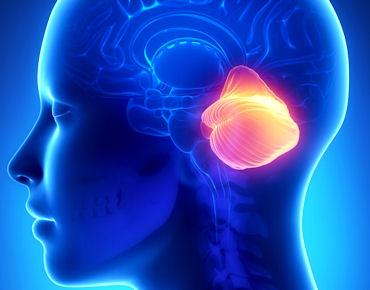Un estabilizador propioceptivo portátil para la rehabilitación de las extremidades y la ataxia de la marcha en ataxias cerebelosas hereditarias: Estudio piloto abierto
Fuente, 4 de enero de 2017
Resumen
El objetivo de este estudio piloto es poner a prueba la viabilidad y la eficacia de un estabilizador propioceptivo portátil que emite vibraciones mecánicas focales en pacientes afectados por ataxias cerebelosas hereditarias.
Se pidió a once pacientes adultos con un diagnóstico genético confirmado de ataxia espinocerebelosa autosómica dominante o de ataxia de Friedreich que llevar un dispositivo activo durante 3 semanas.
Las evaluaciones se llevaron a cabo al inicio, después del uso del dispositivo ( T 1), y 3 semanas después de ( T 2). SARA, 9-HPT, PATA, 6MWT, y los parámetros espaciales y temporales de la marcha, medidos con un sensor inercial BTS-G-Walk, se utilizaron como criterios de valoración del estudio.
Como era de esperar, no se observaron efectos adversos. Estadísticamente se observaron mejoras significativas entre T 0 y T 1 en SARA, 9HPT, prueba de PATA, 6MWT, en la cadencia, duración del ciclo, ciclo de apoyo derecho, ciclo de apoyo izquierdo, ciclo de doble apoyo derecho, ciclo de doble apoyo izquierdo, ciclo de único apoyo derecho, y en el ciclo de apoyo individual izquierdo.
Todos los parámetros mejoraron en T 1 no se mostraron diferencias estadísticamente significativas en T 2, con la excepción de la duración del ciclo.
Este pequeño estudio abierto muestra una evidencia preliminar de que la vibración mecánica focal ejercida por un estabilizador propioceptivo portátil podría mejorar la ataxia de las extremidades y de la marcha en pacientes afectados por ataxias cerebelosas hereditarias.
Palabras clave
Ataxias cerebelosas hereditarias, ataxia de la marcha, Neurorehabilitación, vibraciones mecánicas Focales
Referencias:
- Jayadev S, Bird TD (2013) Hereditary ataxias: overview. Genet Med 15:673–683CrossRefPubMedGoogle Scholar
- 2.Schniepp R, Wuehr M, Schlick C, Huth S, Pradhan C, Dieterich M et al (2014) Increased gait variability is associated with the history of falls in patients with cerebellar ataxia. J Neurol 261:213–223CrossRefPubMedGoogle Scholar
- 3.Schieppati M, Crenna P (1984) From activity to rest: gating of excitatory autogenetic afferences from the relaxing muscle in man. Exp Brain Res 56:448–457CrossRefPubMedGoogle Scholar
- 4.Desmedt JE, Godaux E (1978) Mechanism of the vibration paradox: excitatory and inhibitory effects of tendon vibration on single soleus muscle motor units in man. J Physiol 285:197–207CrossRefPubMedPubMedCentralGoogle Scholar
- 5.Burke D, Hagbarth KE, Lofstedt L, Wallin BG (1976) The responses of human muscle spindle endings to vibration during isometric contraction. J Physiol 261:695–711CrossRefPubMedPubMedCentralGoogle Scholar
- 6.Eklund G (1972) General features of vibration-induced effects on balance. Ups J Med Sci 77:112–124CrossRefPubMedGoogle Scholar
- 7.Courtine G, De Nunzio AM, Schmid M, Beretta MV, Schieppati M (2007) Stance- and locomotion-dependent processing of vibration-induced proprioceptive inflow from multiple muscles in humans. J Neurophysiol 97:772–779CrossRefPubMedGoogle Scholar
- 8.Smiley-Oyen AL, Cheng HY, Latt LD, Redfern MS (2002) Adaptation of vibration-induced postural sway in individuals with Parkinson’s disease. Gait Posture 16:188–197CrossRefPubMedGoogle Scholar
- 9.Nardone A, Schieppati M (2005) Reflex contribution of spindle group Ia and II afferent input to leg muscle spasticity as revealed by tendon vibration in hemiparesis. Clin Neurophysiol 116:1370–1381CrossRefPubMedGoogle Scholar
- 10.Bove M, Nardone A, Schieppati M (2003) Effects of leg muscle tendon vibration on group Ia and group II reflex responses to stance perturbation in humans. J Physiol 550:617–630CrossRefPubMedPubMedCentralGoogle Scholar
- 11.Equistasi website. http://www.equistasi.com/en/. Accessed 13 Dec 2013
- 12.Necking LE, Lundstrom R, Dahlin LB, Lundborg G, Thornell LE et al (1996) Tissue displacement is a causative factor in vibration-induced muscle injury. J Hand Surg Br 21:753–757CrossRefPubMedGoogle Scholar
- 13.Alfonsi E, Paone P, Tassorelli C et al (2015) Acute effects of high-frequency microfocal vibratory stimulation on the H reflex of the soleus muscle. A double-blind study in healthy subjects. Funct Neurol 30(4):269–274PubMedGoogle Scholar
- 14.Volpe D, Giantin MG, Fasano A (2014) A wearable proprioceptive stabilizer (Equistasi®) for rehabilitation of postural instability in Parkinson’s disease: a Phase II Randomized Double-Blind, Double-Dummy, Controlled Study. Quinn TJ, ed. PLoS One 9(11):e112065CrossRefPubMedPubMedCentralGoogle Scholar
- 15.Spina E, Carotenuto A, Aceto MG, Cerillo I, Silvestre F, Arace F, Paone P, Orefice G, Iodice R (2016) The effects of mechanical focal vibration on walking impairment in multiple sclerosis patients: a randomized, double-blinded vs placebo study. Restor Neurol Neurosci:1–8 (preprint)
- 16.Pazzaglia C, Camerota F, Germanotta M, Di Sipio E, Celletti C, Padua L (2016) Efficacy of focal mechanic vibration treatment on balance in Charcot-Marie-Tooth 1A disease: a pilot study. J Neurol 263(7):1434–1441CrossRefPubMedGoogle Scholar
- 17.ATS statement: guidelines for the six-minute walk test, (2002) ATS Committee on Proficiency Standards for Clinical Pulmonary Function Laboratories. Am J Respir Crit Care Med 166(1):111–117CrossRefGoogle Scholar
- 18.Weyer A, Abele M, Schmitz-Hubsch T, Schoch B, Frings M, Timmann D (2007) Reliability and validity of the scale for the assessment and rating of ataxia: a study in 64 Ataxia patients. Mov Disord 22:1633–1637CrossRefPubMedGoogle Scholar
- 19.De Nunzio AM, Nardone A, Picco D, Nilsson J, Schieppati M (2008) Alternate trains of postural muscle vibration promote cyclic body displacement in standing parkinsonian patients. Mov Disord 23:2186–2193CrossRefPubMedGoogle Scholar
- 20.Thompson M, Medley A (2007) Forward and lateral sitting functional reach in younger, middle-aged, and older adults. J Geriatr Phys Ther 30:43–48CrossRefPubMedGoogle Scholar
- 21.Schmitz-Hübsch T, Fimmers R, Rakowicz M, Rola R, Zdzienicka E, Fancellu R et al (2010) Responsiveness of different rating instruments in spinocerebellar ataxia patients. Neurology 74:678–684CrossRefPubMedGoogle Scholar
- 22.Schwesig R, Leuchte S, Fischer D, Ullmann R, Kluttig A (2011) Inertial sensor based reference gait data for healthy subjects. Gait Posture 33:673–678CrossRefPubMedGoogle Scholar
- 23.Roll JP, Vedel JP (1982) Kinaesthetic role of muscle afferents in man, studied by tendon vibration and microneurography. Exp Brain Res 47:177–190CrossRefPubMedGoogle Scholar
- 24.Marsden CD, Meadows JC, Hodgson HJ (1969) Observations on the reflex response to muscle vibration in man and its voluntary control. Brain 92:829–846CrossRefPubMedGoogle Scholar
- 25.Kording KP, Wolpert DM (2006) Bayesian decision theory in sensorimotor control. Trends Cogn Sci 10:319–326CrossRefPubMedGoogle Scholar
- 26.Lackner JR, Levine MS (1979) Changes in apparent body orientation and sensory localization induced by vibration of postural muscles: vibratory myesthetic illusions. Aviat Space Environ Med 50:346–354PubMedGoogle Scholar








